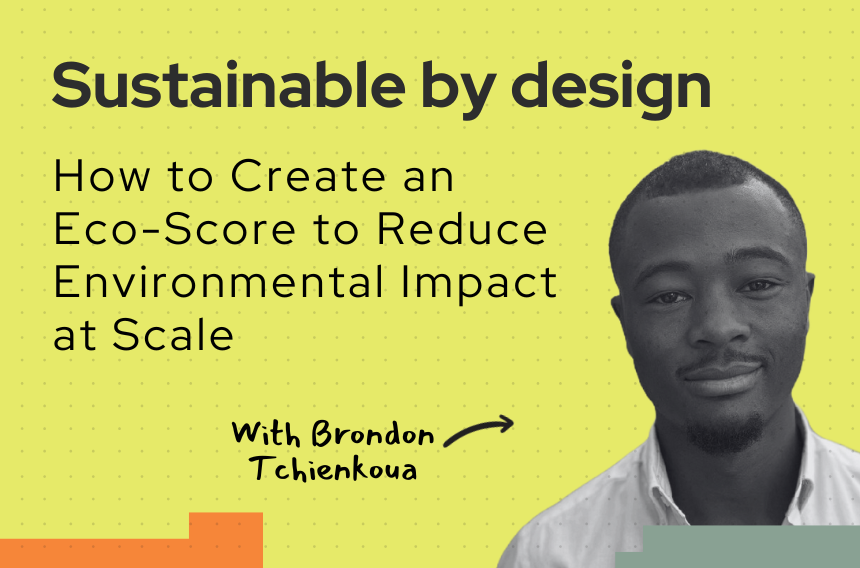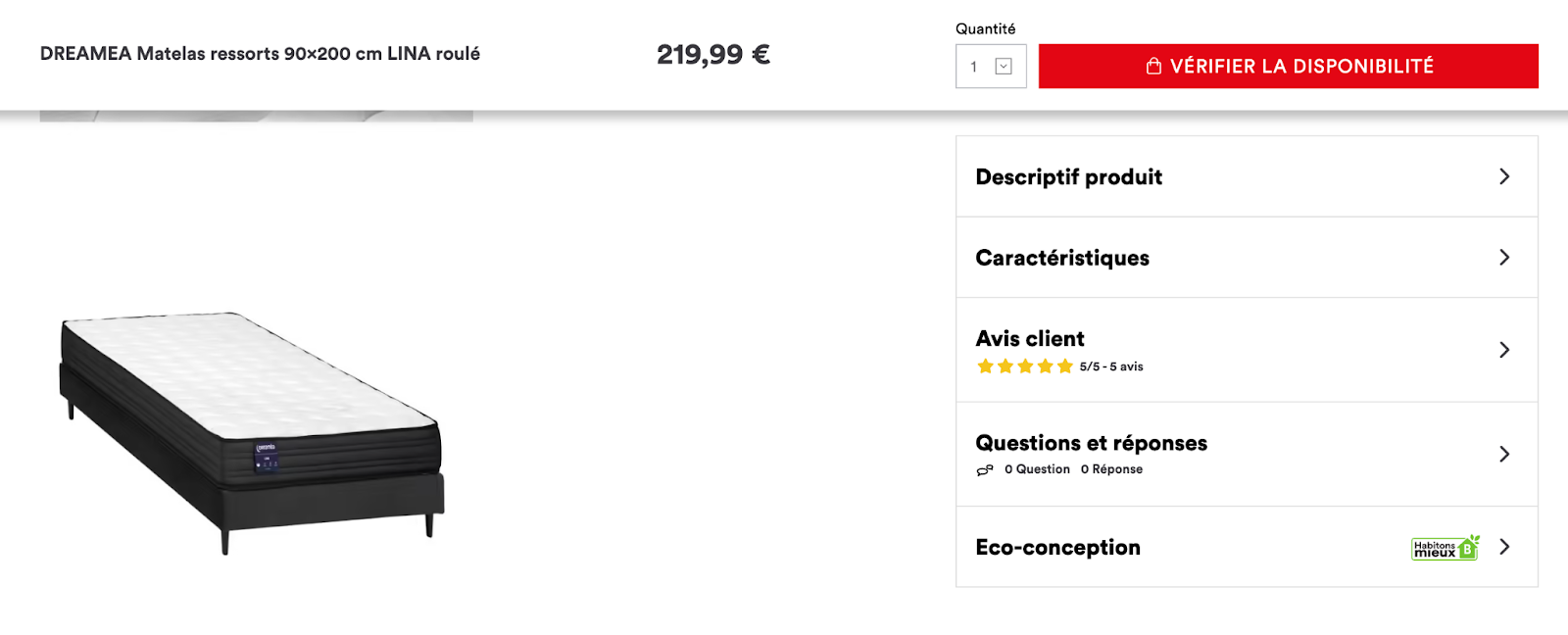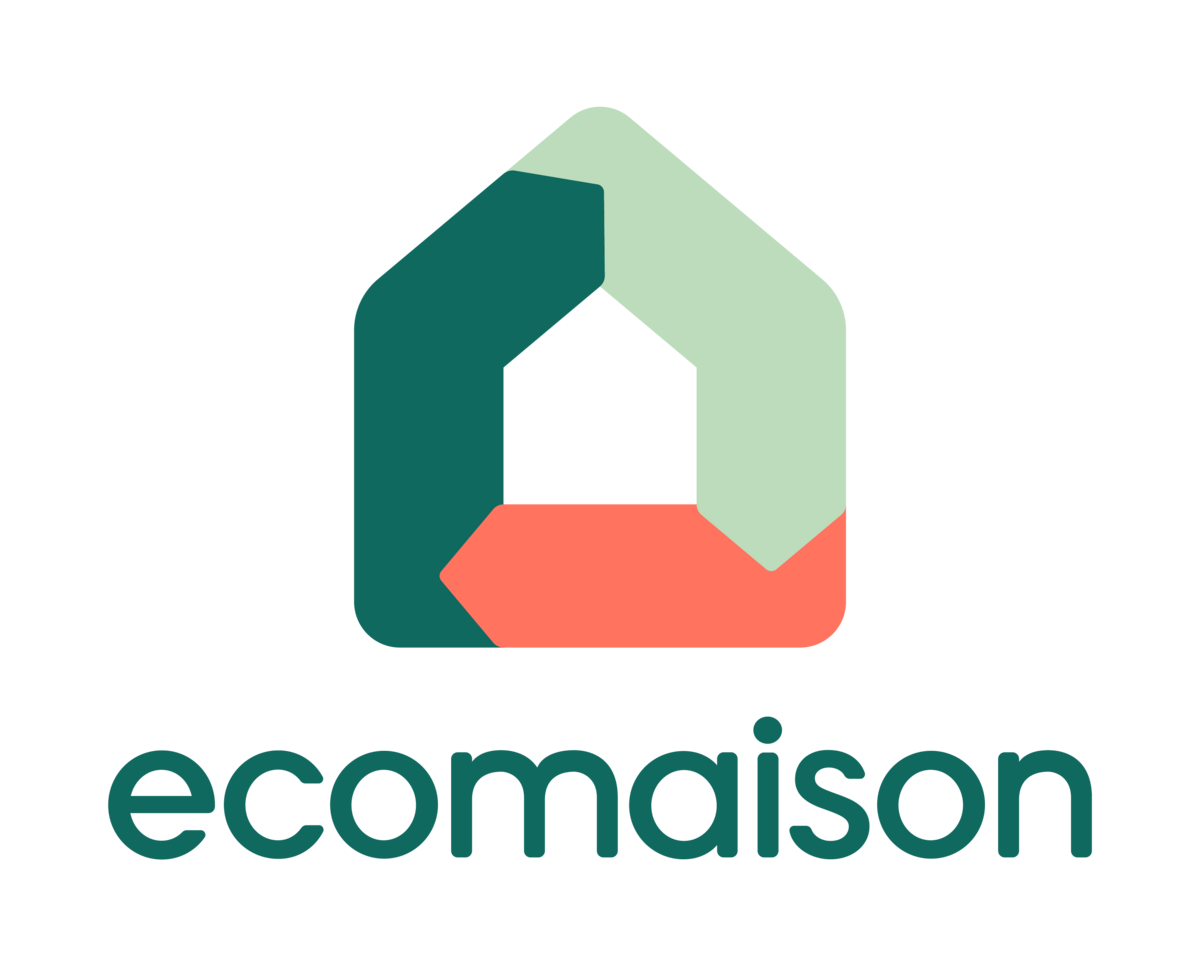
Below is a transcript of our discussion with Brondon Tchienkoua, eco-design engineer at BUT.
We recorded this discussion as part of our Sustainable by Design podcast.
In this episode, we explore how the company created an internal eco-score to better align reduction efforts and inform clients about the environmental impacts of its products.
Note: This transcript was slightly edited to improve readability.
Greg : Today, I'm with Brondon Tchienkoua, eco-design engineer at BUT, and we're going to discuss the use of eco-scores as a sustainability driver. Welcome to the show, Brondon.
Brondon: Hi Grégoire. Thanks for having me. I'm glad to be here.
Greg: It's a pleasure to have you. First, Brondon, could you introduce yourself to the audience?
Brondon: Yes, of course. I'm Brondon Tchienkoua, head of eco-design for the BUT and Conforama group. Today, I’ve been focusing more on BUT, where I’ve been leading the EcoSign project for the past four years.
Greg: Great. And for people who don’t know BUT, can you tell us about it—and maybe a bit about Conforama as well?
Brondon: BUT is a French retailer specializing in home equipment and furnishings. It's the second-largest furniture retailer in France, with €2.5 billion in annual revenue and over 9,000 employees. The company has been around for over 50 years and is now the leading home equipment network in France, with more than 340 stores.
In fact, 80% of the French population lives within 20 minutes of a BUT store.
Greg: That’s impressive.
Brondon: Regarding our products, BUT offers a very wide range—from furniture and decoration to household appliances, bedding, and kitchenware. Online, we offer more than 350,000 product references, and in-store we have about 15,000.
Greg: That’s impressive. Like you, Brondon, I’m French, so I know how big BUT is. For anyone who doesn’t live in France, it’s a store you can’t miss—there are BUT stores everywhere. It’s really a household name.
Now, shifting to sustainability—could you tell us a bit about BUT’s sustainability roadmap?
Brondon: Yes. BUT is now owned by an Austrian group called XXXLutz and an American investment fund, CD&R, which is particularly interested in CSR topics.
In 2021, BUT set an ambitious goal: to become the leading brand for home equipment that’s accessible to everyone and respectful of the environment. The aim is to transform our business model to support the transition toward sustainable living. So, we built an entire roadmap under the slogan "Habitons Mieux"—Living Better—which covers all aspects of corporate social responsibility, like ensuring wellbeing at work and supporting the circular economy. And most importantly for our discussion today: advancing the eco-design of our products.
For the past two years, we’ve also been committed to a decarbonization strategy aligned with the SBTi—Science-Based Targets initiative—aiming to reduce our carbon footprint by 42% by 2030.
Since 80% of our carbon footprint comes from the products and services we offer, it makes a lot of sense to focus on eco-design. It's one of the most powerful levers we have to decarbonize our operations.
Greg: That sounds great. And it’s so exciting to see such a mainstream brand going all in on sustainability—especially since BUT was not traditionally known for that. It was more known for accessibility—affordable products. So seeing it now committed to the SBTi with ambitious targets is very positive.
Brondon: Yes, of course.
Greg: Today, I’d like to talk about the eco-score you developed and released for BUT. I think it’s quite a unique initiative, especially for a mainstream brand. First, I’m curious: how does it work? What’s the context behind the creation of this eco-score? Why was it launched?
Brondon: As I said earlier, our top management is very committed to sustainability and CSR. Our president, Alexandre Falck, CEO of the BUT and Conforama group, and Anne-Laure Feldkircher, Managing Director of BUT, have specific expectations around eco-design because it’s the main lever to create new value for the products we offer.
When we started the eco-design project in 2021, we asked ourselves a fundamental question: what exactly is an eco-designed product? It’s a tricky question, especially when you're talking about a wide range of products—furniture, decoration, electrical appliances.
So, we based our work on life cycle analysis (LCA) to measure and understand the environmental impact of our products and identify the hotspots in each category. For us, LCA is the most advanced tool for measuring a product’s environmental impact.
However, when it comes to promoting eco-design and systematically integrating environmental criteria into our procurement processes with suppliers, LCA becomes too complex.
If I ask a factory to reduce the climate change impact of a chair by 50%, it’s difficult for them to act on that because the level of maturity isn’t always high, and the data required for LCA is often hard to gather.
So we built an eco-design reference system based on LCA, which combines the environmental issues specific to each product category and identifies the levers to work on. The Habitons Mieux score is the result of this—it reflects the product’s entire lifecycle and incorporates predefined best practices for minimizing impact.
It allows us to define eco-design thresholds for scores like A or B, and gives customers a simple benchmark in-store to include the environmental dimension in their purchasing decisions.

Greg: That’s so interesting. Last month, we discussed LCA with Sara Gripstrand, sustainability manager at Lintex, and she said what everyone in the industry knows: LCA is great but hard to understand for non-experts—whether it's someone in purchasing or an end customer.
So it’s great that you managed to translate LCA into a score everyone can understand. I guess having the eco-score is the result of a long process. Could you walk us through the implementation steps?
Brondon: I’ll try to be concise, even though it was a long process—we’ve been working on this since 2021, so three years to reach a final result.
The first step was conducting LCAs on representative functional units across different product categories. This helped us understand how products behave across the lifecycle and value chain.
Based on those results, we created environmental profiles for each category. For example, over 60% of a furniture product’s impact comes from raw materials, while most of the impact for household appliances is generated during the use phase.
From there, we studied best practices for eco-design at each lifecycle stage and used comparative LCAs to measure the reduction potential of each lever.
We also included some topics not easily measured by LCA—like wood traceability or recyclability at end-of-life.
We then defined the most relevant criteria in a scoring grid, weighted them based on importance, and used that to calculate the eco-score. Since 2023, we’ve deployed the score across various product categories, with validation from the Pôle Éco-Conception—France’s national reference center—and support from an eco-innovation agency called Think+.
Greg: That’s very clear. So first, analysis. Then identifying best practices. Then evaluating products.
I'm curious—how has this score changed the way you do business at BUT? Who uses it? Purchasing teams? Marketing teams? What did it change internally?
Brondon: The main objective was to systematically integrate environmental criteria into product development. The score serves as an indicator when selecting products. For our colleagues in product selection, purchasing, and sourcing, it gives them a quick evaluation method before product development starts. They can assess whether improvements are needed to reach a certain threshold.
We’ve also set internal targets—each team has objectives to ensure a certain percentage of products are rated A or B. This helps drive continuous improvement across the product range.
Greg: That’s so interesting. And what’s the current threshold? What percentage of products need to be A or B?
Brondon: Our goal is for 100% of products to be A or B by 2030. That aligns with our decarbonization targets.
To get there, we’re focusing first on best-selling products, since they represent the highest sales volume. We're giving suppliers specific specifications to help bring these products up to A or B level.
Greg: That makes perfect sense. It’s ambitious, but now that you have the system, it’s worth making the most of it.
What kind of benefits have you seen from the eco-score?
Brondon: Many! Structurally, it's helped integrate eco-design into our processes. It translates LCA into a concrete and operational strategy, allowing us to define realistic targets based on industry best practices.
It also helps clarify roles between retailers and manufacturers. Since we don’t manufacture ourselves, we depend entirely on suppliers. This approach gives them simple, clear requests to work with.
Finally, it helps everyone in the value chain take ownership of eco-design and increase their maturity.

Greg: That’s great. Speaking of suppliers, how did they react to the score? Was it difficult for them to implement?
Brondon: Reactions varied. Fortunately, we have many suppliers in France who are already mature on sustainability topics. But it’s more complex with international sourcing—especially in Asia. There, it’s harder to talk about sustainability, collect reliable data, and build trust.
It was difficult at the beginning, but we’re making progress.
Greg: What kind of data do you need from suppliers? Was it data you already had, or did you have to create new workflows?
Brondon: We had to collect data we’d never asked for before. If suppliers didn’t have it, they had to ask their own upstream suppliers. The value chain wasn’t prepared.
When data is missing, the product score decreases. So the first job is collecting reliable data. We don’t collect exhaustive LCA data, but enough to get a qualitative performance level. The next step is to eventually run full LCAs on each product.
Greg: That’s impressive. It sounds simple when you explain it, but I imagine with your huge catalog, it was a massive effort.
What were the biggest challenges?
Brondon: Oh, many! First, integrating environmental criteria across so many diverse product categories. Then onboarding the entire value chain, both internal and external sourcing—Asia, Western Europe, etc.—with very different levels of maturity.
The biggest challenge is data—availability and reliability. We're asking for things that were never requested before.
And for a company like BUT, whose DNA is affordability, it's not easy to combine eco-design with low prices. That’s our main challenge.
Greg: Interesting. And now that you've been working on this for four years, would you say the project increases costs for customers? Or do you see savings?
Brondon: Good question—and tricky to answer. We do need to invest upfront, especially with suppliers who need to change long-standing practices. We invest with them, as they’re motivated but don’t always have the resources.
But we’re already seeing benefits. For example, with Extended Producer Responsibility, we pay an eco-fee based on recyclability. The more eco-designed our products are, the less we pay.
These savings are passed on to consumers. We also get bonuses when using recycled materials. So long-term, yes, there are savings—but it’s still hard to measure precisely.

Greg: That’s great. For those unfamiliar with the French market: when you buy furniture in France, there's a recycling fee, and this effort helps reduce it. That’s a win.
So what’s next for the eco-score?
Brondon: We're focusing on digitalization. We’ve launched a project to digitalize our eco-design and traceability processes. We’re working with two tools—one for wood traceability and raw materials, and one for LCAs.
The goal is to scale up, improve data reliability, and prepare for new regulations like the Digital Product Passport.
Greg: Great. Which tools are you using?
Brondon: For traceability, we use OPT Chain, a Canadian tool. For LCA, we use PefTrust, a French company.
Greg: Yes, they’re very well known in fashion—but I heard they’re moving into furniture too.
Before these tools, I guess you worked with Excel?
Brondon: Yes—lots of Excel. I’ve become an expert! We used Excel, SharePoint, and Drive to store everything. But to scale and prepare for regulations, we needed real systems—for traceability, evidence, and auditability.
Greg: I get it. Poor you, doing all this in Excel!
And regarding the digital passport—you’re already preparing for it?
Brondon: Yes. We're anticipating what criteria will be required and preparing to follow the PEF method. Today, we work mostly with the French method (like BPX), but we’re ready for European rules—starting with mattresses in 2028, and furniture in 2029.
Greg: So you're doing the hard work now—real sustainability and impact reduction—and you’re also ready for upcoming regulations. Very impressive.
Brondon: Maybe not fully ready, but we’re preparing!
Greg: Last question: what tips would you give to someone who wants to implement an eco-score in their company?
Brondon: First, understand your value chain. The level of eco-design depends on supplier maturity. We mapped our supply chain and assessed their maturity levels, and adapted our requirements accordingly.
Second, adapt data collection to what suppliers can actually provide. If they can’t provide the data, you’ll be blocked.
Third, get external support—an expert agency for consulting, and a third-party organization like Pôle Éco-Conception or Bureau Veritas to validate and accredit your approach. That helps anticipate regulations and adds credibility.
Greg: Amazing. Thanks so much, Brondon. This was incredibly insightful, and I’m really impressed by what you've accomplished—especially at the scale you're operating. Congrats!
Brondon: Thank you very much, Greg.


